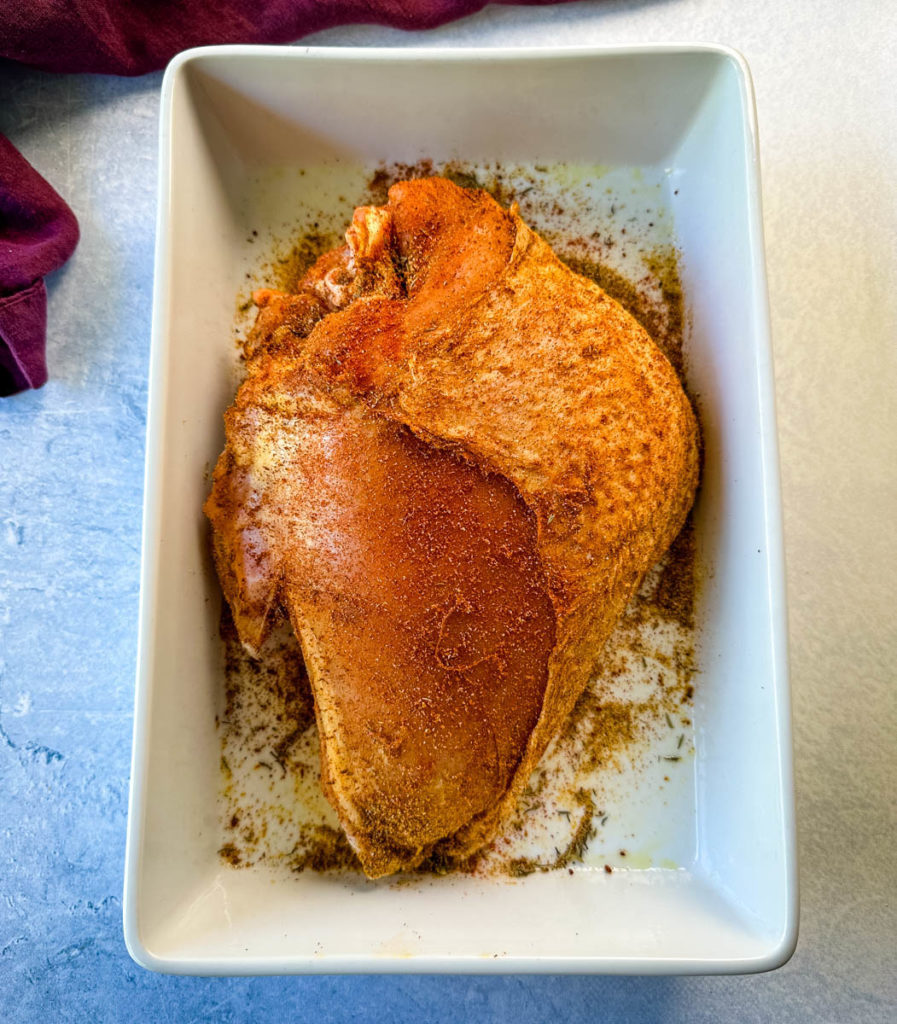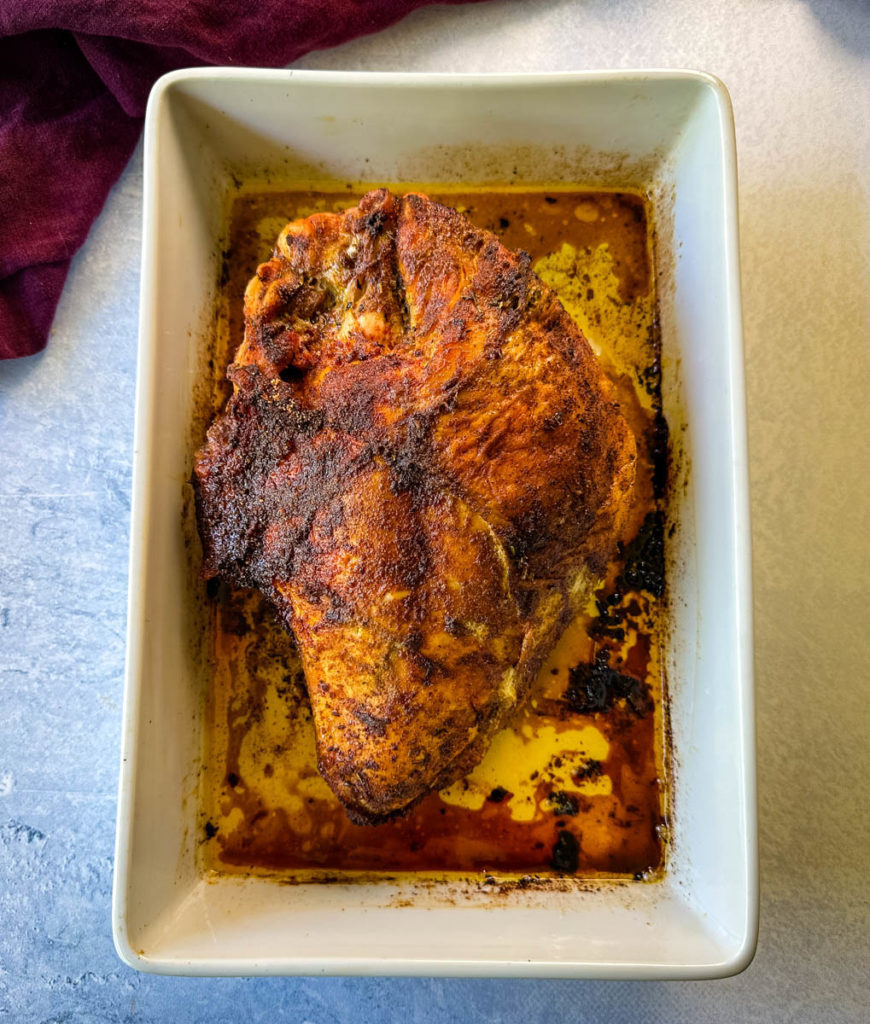This turkey breast is perfectly roasted and features tender, juicy slices expertly seasoned and cooked to golden perfection. Whether you’re hosting a festive holiday gathering or simply craving a delectable meal, this mouth-watering dish is sure to be a crowd-pleaser. Pair it with your favorite sides and garnish with fresh herbs.

Bone-in vs Boneless Turkey
When it comes to turkey breast, there are two main options: bone-in turkey breast and boneless turkey breast. I use a bone-in breast for this recipe. Here are some key differences:
- Bone-in turkey breast refers to a cut of turkey that includes the breast meat along with the rib bones. The breast meat is attached to the bone, which provides additional flavor and moisture during cooking. The bone acts as a heat conductor and helps distribute heat evenly, resulting in a more even cooking process.
- Boneless turkey breast is essentially the breast meat without the bone. It provides a more convenient and easier option for cooking and carving.
Pros of Bone-in Turkey Breast:
- Enhanced flavor: The bone imparts flavor to the meat during cooking, resulting in a richer taste.
- Moisture retention: The bone helps retain moisture in the meat, making it less likely to dry out.
Cons of Bone-in Turkey Breast:
- Carving difficulties: Removing the bone can be a bit more challenging and time-consuming, especially if you’re not experienced with carving poultry.
- Uneven cooking: The bone can create variations in cooking time, potentially leading to parts of the breast being overcooked or undercooked.
Pros of Boneless Turkey Breast
- Easy carving: Without the bone, carving the meat becomes simpler and faster.
- Uniform cooking: The absence of bones allows for more even cooking throughout the breast meat.
Cons of Boneless Turkey Breast
- Potential for dryness: Boneless turkey breast has a slightly higher chance of drying out during cooking since it lacks the natural moisture retention properties of the bone.
- Potential for slightly less flavor: The bone contributes to the overall flavor of the meat, so boneless turkey breast may have a slightly milder taste in comparison.

Spices and Seasoning
I use a combination of poultry seasoning, smoked paprika (regular paprika is fine), onion powder, salt, and pepper.
Here are some additional options:
- Sage: This is a classic herb for turkey that adds a warm, earthy flavor. You can use fresh or dried sage.
- Rosemary: Rosemary has a strong, piney flavor that can be used sparingly to add depth.
- Cumin: Has a warm, earthy flavor that can add a slightly spicy kick.
- Cayenne pepper: Adds a spicy kick to the turkey that can be adjusted to your preference.
- Cajun Seasoning
- Creole Seasoning
- Lemon Pepper

How to Make Roasted Turkey Breast
Detailed measurements and full instructions can be found in the recipe card at the bottom of this post.
- Pat the turkey breast dry.
- Place the turkey breast in a roasting pan or 9×13-inch baking dish with the skin side up.
- Rub the spices into the turkey and season all sides. Cut the butter into small slices and place the slices over the seasoned turkey.
- Place the pan in the oven and bake.
- Remove the turkey breast from the oven and let it rest.
- Slice the turkey breast and serve.
Do You Have to Brine it
Brining is not required. It involves soaking the turkey breast in a saltwater solution, often with additional herbs and spices, before cooking. The brine helps to season the meat and also allows it to retain more moisture during the cooking process, usually resulting in a juicier and more flavorful turkey breast.
If you’re short on time or prefer a simpler approach, you can still achieve delicious results by seasoning the turkey breast without brining by following the recipe and instructions noted below.
If you choose to brine your turkey breast, make sure to plan ahead as it requires additional time for the brining process.


Cook Time/How Long to Cook
The cook time will depend on several factors, especially the size of the breast. As a general rule, you should plan to roast the turkey for about 20 minutes per pound of turkey. This remains true for bone-in and boneless.
- 3-4 pounds: 1 to 2 hours
- 4-6 pounds: 2 to 2.5 hours
- 6-8 pounds: 2.5 to 3 hours
How to Tell When it’s Done
You will need to use a meat thermometer. Cook the turkey until it reaches an internal temperature of 165 degrees. Insert the thermometer into the thickest part of the turkey.

Crispy Skin
This recipe produces amazing skin. If you want it more crisp, once the turkey has finished roasting, adjust the oven to broil and broil the turkey for a few minutes until the skin crisps to your liking.
Allow the Turkey to Rest
When a turkey breast is cooked, the heat causes the juices inside the meat to move away from the center of the roast towards the outside. This can result in a dry, tough piece of meat if it is cut immediately after being taken out of the oven.
By letting it rest for at least 10-15 minutes after cooking, you allow the juices to redistribute back into the meat, resulting in a more evenly moist and tender roast. This also allows the temperature to even out, so the meat is not too hot when you start carving it.

Gravy
While the turkey breast is resting, it’s a good time to make the gravy. You can use the juices that have collected in the bottom of the roasting pan to make a flavorful gravy to accompany the turkey. Check out my Turkey Gravy From Drippings and Yellow Gravy recipes.
Freezer Tips
Cut the turkey into smaller pieces or portions that are the appropriate size for your needs. This will make it easier to store and defrost later on.
Wrap the turkey in plastic wrap or aluminum foil to prevent freezer burn and moisture loss. You can also place it in freezer-safe plastic bags or containers.
You can freeze it for up to 6 months.
Thaw overnight in the fridge.

How to Reheat Leftovers
- Oven method: Preheat your oven to 325 degrees and place the leftover turkey in a baking dish or on a baking sheet, covering it loosely with aluminum foil to prevent drying. Heat until warm.
- Microwave method: Slice the leftover turkey breast into smaller, even-sized pieces for more even reheating. Place the slices on a microwave-safe plate and cover them with a microwave-safe cover or microwave-safe plastic wrap. Heat on medium power in short intervals, typically around 1-2 minutes at a time.
- Stovetop method: Cut the leftover turkey into smaller slices or pieces. Heat a non-stick skillet or frying pan over medium heat. Add a small amount of oil or butter to the pan and place the turkey slices in the pan. Heat until warm.
Pair With These Recipes
Collard Greens with Ham Hocks
Southern Candied Sweet Potatoes
Southern Cornbread Recipe
Slow Cooker Crockpot Oxtails
More Turkey and Poultry Recipes
Boneless Turkey Breast Roast
Juicy Spatchcock Turkey
Cajun Roasted Turkey
Air Fryer Turkey Breast
Baked Turkey Legs
Smoked Duck
Crockpot Slow Cooker Bone-in Turkey Breast
Roasted Turkey Breast
Ingredients
- 2-7 pound bone-in turkey breast Mine weighed 3 1/2 pounds.
- 2 tablespoons unsalted butter
Homemade Rub and Spices (Feel free to use your favorite store-bought rub if preferred.)
- 1/2 teaspoon garlic powder
- 1/2 teaspoon onion powder
- 1/2 teaspoon ground thyme
- 1/2 teaspoon smoked paprika Regular paprika is fine.
- 2 teaspoons poultry seasoning
- salt and pepper to taste
Instructions
- Preheat oven to 375 degrees.
- Pat the turkey breast dry.
- Place the turkey breast in a roasting pan or 9×13 inch baking dish with the skin side up.
- Rub the spices into the turkey and season all sides. Cut the butter into small slices and place the slices over the seasoned turkey.Alternatively, you can place the butter under the skin of the turkey if you wish. You can use your fingers to gently separate the skin from the meat, being careful not to tear the skin (I find this sometimes difficult to accomplish so I don't do it). Once you've created a pocket, you can place small pieces of butter or a seasoned butter mixture under the skin, spreading it out evenly over the surface of the breast.
- Place the pan in the oven and bake until the turkey reaches an internal temperature of 165 degrees. Test the thickest part of the turkey with a meat thermometer. You should plan for it to cook for about 20 minutes per pound of turkey. Ultimately, it's done when it's done which will vary based on the size you are using.
- Remove the turkey breast from the oven and let it rest for 10-15 minutes before slicing and serving.
- Slice the turkey breast and serve.
Notes
- You can use a whole or split turkey breast, whatever size you prefer.
- Thaw the turkey breast before using.
- Season the turkey however you wish. Feel free to use your favorite rubs!
- Cook time will vary based on the size and weight of your turkey. Always use a meat thermometer to avoid guessing.
- You don’t have to place butter under the skin of a turkey breast, but it can help to add flavor and moisture to the meat. Placing butter or another fat under the skin creates a barrier between the meat and the dry heat of the oven, which helps to keep the meat juicy and tender. I find that placing butter on the breast and allowing it to penetrate while it bakes accomplishes the same thing.

